
Optics is the branch of physics that studies the behaviour and properties of light, including its interactions with matter and the construction of instruments that use or detect it. Optics usually describes the behaviour of visible, ultraviolet, and infrared light. Because light is an electromagnetic wave, other forms of electromagnetic radiation such as X-rays, microwaves, and radio waves exhibit similar properties.

A camera obscura is a darkened room with a small hole or lens at one side through which an image is projected onto a wall or table opposite the hole.

A view camera is a large-format camera in which the lens forms an inverted image on a ground-glass screen directly at the film plane. The image is viewed and then the glass screen is replaced with the film, and thus the film is exposed to exactly the same image as was seen on the screen.
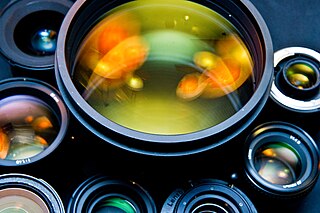
A camera lens is an optical lens or assembly of lenses used in conjunction with a camera body and mechanism to make images of objects either on photographic film or on other media capable of storing an image chemically or electronically.
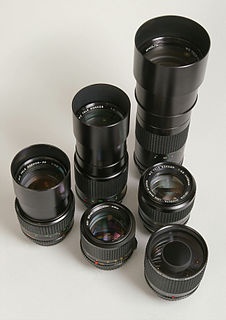
A telephoto lens, in photography and cinematography, is a specific type of a long-focus lens in which the physical length of the lens is shorter than the focal length. This is achieved by incorporating a special lens group known as a telephoto group that extends the light path to create a long-focus lens in a much shorter overall design. The angle of view and other effects of long-focus lenses are the same for telephoto lenses of the same specified focal length. Long-focal-length lenses are often informally referred to as telephoto lenses although this is technically incorrect: a telephoto lens specifically incorporates the telephoto group.

Anticrepuscular rays, or antisolar rays, are meteorological optical phenomena similar to crepuscular rays, but appear opposite the Sun in the sky. Anticrepuscular rays are essentially parallel, but appear to converge toward the antisolar point, the vanishing point, due to a visual illusion from linear perspective.
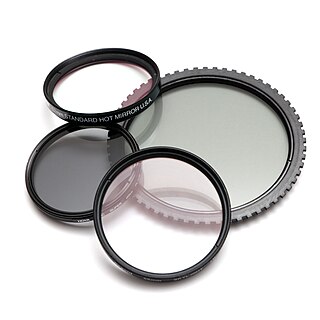
In photography and cinematography, a filter is a camera accessory consisting of an optical filter that can be inserted into the optical path. The filter can be of a square or oblong shape and mounted in a holder accessory, or, more commonly, a glass or plastic disk in a metal or plastic ring frame, which can be screwed into the front of or clipped onto the camera lens.

A sunbeam, in meteorological optics, is a beam of sunlight that appears to radiate from the position of the Sun. Shining through openings in clouds or between other objects such as mountains and buildings, these beams of particle-scattered sunlight are essentially parallel shafts separated by darker shadowed volumes. Their apparent convergence in the sky is a visual illusion from linear perspective. The same illusion causes the apparent convergence of parallel lines on a long straight road or hallway at a distant vanishing point. The scattering particles that make sunlight visible may be air molecules or particulates.

A Brocken spectre, also called Brocken bow, mountain spectre, or spectre of the Brocken is the magnified shadow of an observer cast in mid air upon any type of cloud opposite to a strong light source. Additionally if the cloud consists of water droplets backscattered a bright area called heiligenschein and halo-like rings of rainbow coloured light called a glory can be seen around the head or apperature silhouette of the spectre. Typically the spectre appears in sunlight opposite to the Sun's direction at the antisolar point.
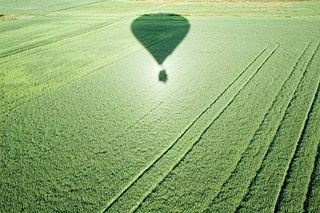
Heiligenschein is an optical phenomenon in which a bright spot appears around the shadow of the viewer's head in the presence of dew. In photogrammetry and remote sensing, it is more commonly known as the hotspot. It is also occasionally known as Cellini's halo after the Italian artist and writer Benvenuto Cellini (1500–1571), who described the phenomenon in his memoirs in 1562.

In geometrical optics, a focus, also called an image point, is a point where light rays originating from a point on the object converge. Although the focus is conceptually a point, physically the focus has a spatial extent, called the blur circle. This non-ideal focusing may be caused by aberrations of the imaging optics. In the absence of significant aberrations, the smallest possible blur circle is the Airy disc, which is caused by diffraction from the optical system's aperture. Aberrations tend to worsen as the aperture diameter increases, while the Airy circle is smallest for large apertures.

The antisolar point is the abstract point on the celestial sphere directly opposite the Sun from an observer's perspective. This means that the antisolar point lies above the horizon when the Sun is below it, and vice versa. On a sunny day, the antisolar point can be easily found; it is located within the shadow of the observer's head. Like the zenith and nadir, the antisolar point is not fixed in three-dimensional space, but is defined relative to the observer. Each observer has an antisolar point that moves as the observer changes position.
This article contains a list of cinematic techniques that are divided into categories and briefly described.
In Gaussian optics, the cardinal points consist of three pairs of points located on the optical axis of a rotationally symmetric, focal, optical system. These are the focal points, the principal points, and the nodal points. For ideal systems, the basic imaging properties such as image size, location, and orientation are completely determined by the locations of the cardinal points; in fact only four points are necessary: the focal points and either the principal or nodal points. The only ideal system that has been achieved in practice is the plane mirror, however the cardinal points are widely used to approximate the behavior of real optical systems. Cardinal points provide a way to analytically simplify a system with many components, allowing the imaging characteristics of the system to be approximately determined with simple calculations.

Perspective control is a procedure for composing or editing photographs to better conform with the commonly accepted distortions in constructed perspective. The control would:

Tilt–shift photography is the use of camera movements that change the orientation or position of the lens with respect to the film or image sensor on cameras.

Miniature faking, also known as diorama effect or diorama illusion, is a process in which a photograph of a life-size location or object is made to look like a photograph of a miniature scale model. Blurring parts of the photo simulates the shallow depth of field normally encountered in close-up photography, making the scene seem much smaller than it actually is; the blurring can be done either optically when the photograph is taken, or by digital postprocessing. Many diorama effect photographs are taken from a high angle to simulate the effect of looking down on a miniature. Tilt–shift photography is also associated with miniature faking.

Tilted plane photography is a method of employing focus as a descriptive, narrative or symbolic artistic device. It is distinct from the more simple uses of selective focus which highlight or emphasise a single point in an image, create an atmospheric bokeh, or miniaturise an obliquely-viewed landscape. In this method the photographer is consciously using the camera to focus on several points in the image at once while de-focussing others, thus making conceptual connections between these points.
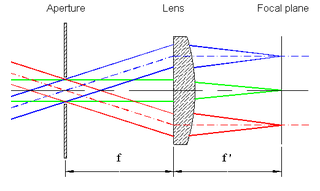
Conoscopy is an optical technique to make observations of a transparent specimen in a cone of converging rays of light. The various directions of light propagation are observable simultaneously.
The design of photographic lenses for use in still or cine cameras is intended to produce a lens that yields the most acceptable rendition of the subject being photographed within a range of constraints that include cost, weight and materials. For many other optical devices such as telescopes, microscopes and theodolites where the visual image is observed but often not recorded the design can often be significantly simpler than is the case in a camera where every image is captured on film or image sensor and can be subject to detailed scrutiny at a later stage. Photographic lenses also include those used in enlargers and projectors.

















